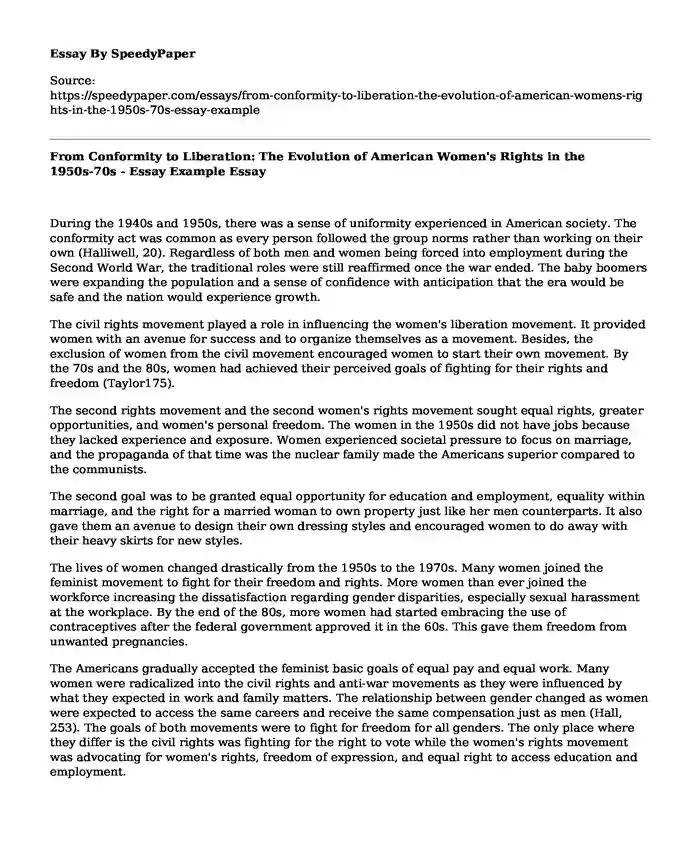
| Type of paper: | Essay |
| Categories: | Women United States Liberty Human rights |
| Pages: | 3 |
| Wordcount: | 602 words |
During the 1940s and 1950s, there was a sense of uniformity experienced in American society. The conformity act was common as every person followed the group norms rather than working on their own (Halliwell, 20). Regardless of both men and women being forced into employment during the Second World War, the traditional roles were still reaffirmed once the war ended. The baby boomers were expanding the population and a sense of confidence with anticipation that the era would be safe and the nation would experience growth.
The civil rights movement played a role in influencing the women's liberation movement. It provided women with an avenue for success and to organize themselves as a movement. Besides, the exclusion of women from the civil movement encouraged women to start their own movement. By the 70s and the 80s, women had achieved their perceived goals of fighting for their rights and freedom (Taylor175).
The second rights movement and the second women's rights movement sought equal rights, greater opportunities, and women's personal freedom. The women in the 1950s did not have jobs because they lacked experience and exposure. Women experienced societal pressure to focus on marriage, and the propaganda of that time was the nuclear family made the Americans superior compared to the communists.
The second goal was to be granted equal opportunity for education and employment, equality within marriage, and the right for a married woman to own property just like her men counterparts. It also gave them an avenue to design their own dressing styles and encouraged women to do away with their heavy skirts for new styles.
The lives of women changed drastically from the 1950s to the 1970s. Many women joined the feminist movement to fight for their freedom and rights. More women than ever joined the workforce increasing the dissatisfaction regarding gender disparities, especially sexual harassment at the workplace. By the end of the 80s, more women had started embracing the use of contraceptives after the federal government approved it in the 60s. This gave them freedom from unwanted pregnancies.
The Americans gradually accepted the feminist basic goals of equal pay and equal work. Many women were radicalized into the civil rights and anti-war movements as they were influenced by what they expected in work and family matters. The relationship between gender changed as women were expected to access the same careers and receive the same compensation just as men (Hall, 253). The goals of both movements were to fight for freedom for all genders. The only place where they differ is the civil rights was fighting for the right to vote while the women's rights movement was advocating for women's rights, freedom of expression, and equal right to access education and employment.
We owe gratitude to the women who participated in the civil rights and women's rights movement. They changed society's perception, making women able to access education and excel in their workplaces without being intimidated or discriminated against. Women have the right to control their personal lives and determine the number of children they want to raise. We have also seen women taking up leadership roles in both politics and workplaces instead of in the past when women only performed traditional roles. Yes, we are grateful for the role the women played in the 50s, 60s, and 70s because they brought liberation to women.
References
Hall, Jacquelyn Dowd. "The long civil rights movement and the political uses of the past." The Best American History Essays 2007. Palgrave Macmillan, New York, 2007. 235-271.
Halliwell, Martin. "American Culture in the 1950s." (2007). 20
Taylor, Verta. "Social movement continuity: The women's movement in abeyance." American Sociological Review (1989): 761-775.
Cite this page
From Conformity to Liberation: The Evolution of American Women's Rights in the 1950s-70s - Essay Example. (2024, Jan 29). Retrieved from https://speedypaper.net/essays/from-conformity-to-liberation-the-evolution-of-american-womens-rights-in-the-1950s-70s-essay-example
Request Removal
If you are the original author of this essay and no longer wish to have it published on the SpeedyPaper website, please click below to request its removal:
- New Presidency Essay Example
- Essay Sample with the Benefits of Immigration both Fiscal and Economic
- Professional Short Term Goals Essay Examples
- Caree Essay Example: Professional Goals
- HRM Essay Example about Absence Culture
- Free Essay: The Role of Effect in Donald Trump's Speeches Contents
- Paper Example. Impacts of Automated Intelligence
Popular categories




